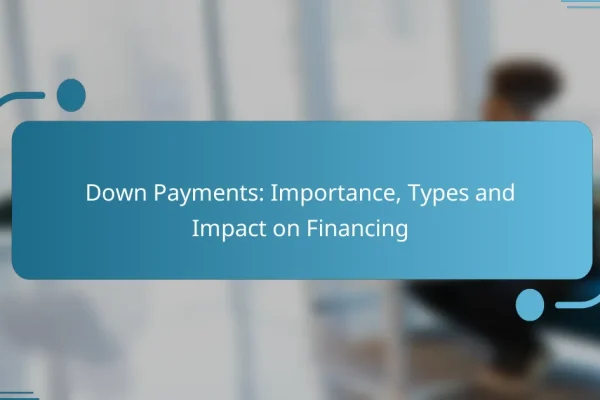What financing options are available in the US?
In the US, various financing options cater to different needs, including personal loans, home equity loans, credit cards, peer-to-peer lending, and small business loans. Each option has unique features, benefits, and considerations that can help individuals and businesses secure the funds they need.
Personal loans
Personal loans are unsecured loans that can be used for various purposes, such as debt consolidation, medical expenses, or major purchases. They typically have fixed interest rates and repayment terms ranging from two to five years.
When considering a personal loan, check your credit score, as it significantly impacts the interest rate you may receive. Loan amounts can vary widely, often from a few thousand to tens of thousands of dollars, depending on the lender and your creditworthiness.
Home equity loans
Home equity loans allow homeowners to borrow against the equity in their property. These loans usually have lower interest rates compared to unsecured loans since they are secured by the home. Borrowers can access a lump sum with fixed repayment terms.
It’s essential to assess your home’s value and your outstanding mortgage balance to determine how much equity you can tap into. Be cautious, as failing to repay a home equity loan could result in foreclosure on your property.
Credit cards
Credit cards provide a revolving line of credit that can be used for everyday purchases or emergencies. They often come with varying interest rates and rewards programs, making them versatile financial tools.
When using credit cards, aim to pay off the balance in full each month to avoid high interest charges. Be mindful of your credit utilization ratio, as keeping it below 30% can positively impact your credit score.
Peer-to-peer lending
Peer-to-peer lending connects borrowers directly with individual lenders through online platforms. This option can offer competitive interest rates and flexible terms, often appealing to those with less-than-perfect credit.
Before opting for peer-to-peer loans, review the platform’s fees and the potential impact on your credit score. Loan amounts can range from a few hundred to tens of thousands of dollars, depending on the lender’s criteria.
Small business loans
Small business loans are designed to help entrepreneurs finance their ventures, covering expenses like equipment, inventory, or working capital. Options include traditional bank loans, SBA loans, and online lenders, each with different terms and requirements.
When applying for a small business loan, prepare a solid business plan and financial projections to present to lenders. Loan amounts can vary significantly, often ranging from a few thousand to millions of dollars, depending on the business’s needs and creditworthiness.
How to choose the right financing option?
Choosing the right financing option involves assessing your financial situation, understanding the terms of various options, and determining what best meets your needs. Consider factors such as your credit score, interest rates, and repayment terms to make an informed decision.
Assessing credit score
Your credit score plays a crucial role in determining your financing options and the interest rates you may receive. Generally, a higher score indicates better creditworthiness, which can lead to lower rates and more favorable terms.
Check your credit report for accuracy and address any discrepancies before applying for financing. Scores typically range from 300 to 850, with scores above 700 considered good. Aim to improve your score by paying bills on time and reducing debt.
Understanding interest rates
Interest rates can significantly impact the total cost of financing. They can vary based on your credit score, the type of loan, and market conditions. Fixed rates remain constant throughout the loan term, while variable rates may fluctuate.
For personal loans, rates can range from low single digits to high teens, depending on your credit profile. Always compare offers from multiple lenders to find the best rate available to you.
Evaluating repayment terms
Repayment terms dictate how long you have to pay back the loan and the structure of your payments. Shorter terms typically mean higher monthly payments but less interest paid over time, while longer terms can lower monthly payments but increase overall interest costs.
Consider your budget and financial goals when evaluating terms. For example, a 5-year term may suit someone looking to pay off debt quickly, while a 15-year term might be better for someone prioritizing lower monthly payments. Always read the fine print for any fees or penalties associated with early repayment.
What are the eligibility requirements for financing?
Eligibility requirements for financing typically include proof of income, a satisfactory credit history, and a manageable debt-to-income ratio. These factors help lenders assess your ability to repay the loan and determine the terms of financing.
Income verification
Income verification is essential for lenders to confirm that you have a reliable source of income to repay the financing. This may involve providing recent pay stubs, tax returns, or bank statements. Self-employed individuals might need to submit additional documentation, such as profit and loss statements.
It’s advisable to have at least two years of consistent income history to strengthen your application. If your income fluctuates, consider providing a detailed explanation to the lender.
Credit history
Your credit history plays a crucial role in determining your eligibility for financing. Lenders typically check your credit score, which reflects your borrowing and repayment behavior. A higher score generally leads to better financing options and lower interest rates.
To improve your credit history, pay off outstanding debts, make payments on time, and avoid opening too many new accounts at once. Regularly reviewing your credit report for errors can also help maintain a good score.
Debt-to-income ratio
The debt-to-income (DTI) ratio measures your monthly debt payments against your gross monthly income. Lenders often prefer a DTI ratio below 36%, although some may allow higher ratios depending on other factors. A lower DTI indicates that you have a manageable level of debt relative to your income.
To calculate your DTI, add up all your monthly debt payments and divide that total by your gross monthly income. If your DTI is high, consider paying down existing debts before applying for financing to improve your chances of approval.
What are the costs associated with financing?
The costs associated with financing typically include interest rates, fees, and insurance requirements. Understanding these elements is crucial for making informed financial decisions and managing overall expenses.
Interest rates
Interest rates represent the cost of borrowing money and can vary significantly based on factors like credit score, loan type, and market conditions. For personal loans, rates might range from low single digits to high teens, while mortgages often fall between 3% and 7% depending on the economic environment.
When considering financing, it’s essential to shop around and compare rates from different lenders. A small difference in interest rates can lead to substantial savings over the life of a loan.
Fees and charges
Fees and charges can include origination fees, closing costs, and prepayment penalties. Origination fees typically range from 1% to 5% of the loan amount, while closing costs for mortgages can add thousands of dollars to the total expense.
Always review the fee structure before committing to a financing option. Look for lenders that offer transparent pricing and consider negotiating fees where possible to reduce overall costs.
Insurance requirements
Many financing options require insurance to protect both the borrower and the lender. For instance, mortgage lenders often mandate homeowners insurance, while auto loans may require comprehensive and collision coverage.
Be aware of the insurance costs when budgeting for financing. These premiums can add significantly to monthly payments, so it’s wise to shop for competitive rates on insurance policies as well.
How to apply for financing options?
Applying for financing options typically involves filling out an application form, providing necessary documentation, and submitting it to the lender. The process can vary based on the type of financing and the lender’s requirements.
Online application process
The online application process for financing options is designed to be straightforward and efficient. Most lenders offer a digital platform where applicants can fill out forms, upload documents, and track their application status in real-time.
To start, gather essential information such as your personal identification, income details, and any relevant financial documents. After filling out the application, review it for accuracy before submission to avoid delays.
Common pitfalls include not providing complete information or failing to meet specific lender requirements. To ensure a smooth process, double-check that all necessary documents are attached and consider reaching out to customer support if you have questions during the application.










